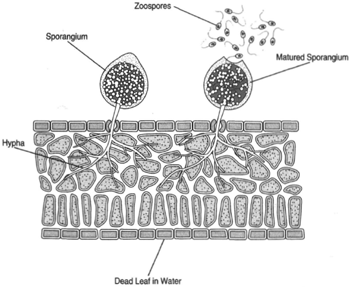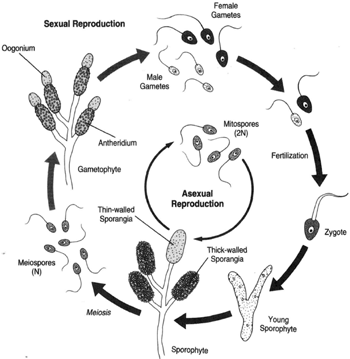Chytridiomycetes
If dead leaves or onion bulb scales are immersed in a little water containing
a bit of soil, an abundance of chytrids will likely appear in a short time. Their
spores seem to be everywhere. They are the simplest of the fungi, reproducing
primarily by zoospores. Some species exhibit alternation of generations.
The simple, globe-shaped Chytridium sphaerocurpum (figure 18-11, which
extends rhizoids into the substrate and produces unicellular sporangia and
zoospores, and Allomyces arbuscula (figure 18-2), which shows alternation of
generations, are two examples of chytrids. Chytrids consist of only a spherical
cell and a few rhizoids that penetrate the host tissue.
 |
| Figure 18-1 Chytridium sphaemrpum growing on a dead leaf in water. |
 |
| Figure 16-2 Allomyces arbuscula. Two kinds of sporangia are produced: thin-walled
sporangia, which produce mitospores, and thick-walled sporangia, which produce
meiospores. The mitospores produce sporophytes, and the meiospores produce
gametophytes. The antheridia are orange in color. A fertilized egg grows into a sporophyte. |
Figure 18-2 shows two types of sporangia on the
Allomyces sporophyte plant: thick-walled sporangia and thin-walled sporangia. In the
thick-walled sporangia, meiosis occurs and the resulting spores, called
meiospores, are haploid. The meiospores grow into gametophytes. In the
thin-walled sporangia, mitosis occurs, and the resulting spores, called
mitospores, are diploid. Mitospores do not produce gametophytes but,
rather, grow into sporophytes. If a culture of
Allomyces were to be dried out,
the thin-walled sporangia would not survive and the thick-walled
sporangia would. Such treatment would therefore ensure alternation of
generations. The rendering of the gametophyte in figure 18-2 shows two
kinds of gametangia: the antheridia, situated below, and the oogonia,
located above. Whereas the antheridia (male gametangia) are orange in color,
the female gametangia are colorless. When the gametes unite, a biflagellated
zygote forms, which, in turn, grows to a sporophyte thallus. Sperm cells
are attracted to the egg by a hormonal substance having the romantic
name sirenin.






